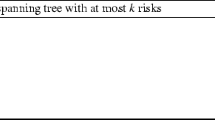Abstract
The MPLS platform enables the implementation of advanced multipath and multicast routing schemes. This work develops and analyses the performance of a new bi-criteria minimum spanning tree model intended for routing broadcast messages in MPLS networks or constructing tree-based overlay networks. The aim of the model is to obtain spanning trees which are compromise solutions with respect to two important traffic engineering metrics: load balancing cost and average delay bound. An exact solution to the formulated bi-criteria optimization problem is presented, which is based on an algorithm that enables the computation of the set of supported non-dominated spanning trees. An application model and a set of experiments on randomly generated Internet type topologies will also be presented. Finally a network performance analysis of the model considering three network performance metrics will be shown.
Similar content being viewed by others
References
Ahuja, R., Magnanti, T., & Orlin, J. (1993). Network flows—theory, algorithms and applications. New York: Prentice Hall.
Awduche, D., Chiu, A., Elwalid, A., Widjaja, I., & Xiao, X. (2002). Overview and principles of Internet traffic engineering. IETF Network Working Group, RFC3272.
Calvert, K., & Zegura, E. (1996). GT Internetwork Topology Models (GT-ITM). College of Computing, Georgia Institute of Technology. http://www.cc.gat-ech.edu/fac/Ellen.Zegura/graphs.html.
Cerulli, R., Fink, A., Gentili, M., & Voss, S. (2006). Extensions of the minimum labelling spanning tree problem. Journal of Telecommunications and Information Technology, 4, 39–45.
Clímaco, J., Craveirinha, J., & Pascoal, M. (2006). An automated reference point-like approach for multicriteria shortest path problems. Journal of Systems Science and Systems Engineering, 15(3), 314–329.
Clímaco, J., Craveirinha, J., & Pascoal, M. (2007). Multicriteria routing models in telecommunication networks—overview and a case study. In Y. Shi, D. Olson, & A. Stam (Eds.), Advances in multiple criteria decision making and human systems management: knowledge and wisdom (pp. 17–46). Amsterdam: IOS Press, edited in honor of Milan Zeleny, Chap. 1.
Cohen, J. (1978). Multiobjective programming and planning. San Diego: Academic Press.
Craveirinha, J., Clímaco, J., Pascoal, M., & Martins, L. (2007). Traffic splitting in MPLS networks—a hierarchical multicriteria approach. Journal of Telecommunications and Information Technology, 4, 3–10.
Doar, M., & Leslie, I. (1993). How bad is naive multicast routing. In INFOCOM (1) (pp. 82–89), San Francisco, USA.
Erbas, S., & Erbas, C. (2003). A multiobjective off-line routing model of MPLS networks. In Proceedings 18th int. teletraf. congr., Berlin, Germany.
Erdös, P., & Rényi, A. (1959). On random graphs. Publicationes Mathematicae, 6, 290–297.
da Silva, C. G. & Clímaco, J. (2007). A note on the computation of ordered supported non-dominated solutions in the bi-criteria minimum spanning tree problems. Journal of Telecommunications and Information Technology, 4, 11–15.
Hamacher, H., & Ruhe, G. (1994). On spanning tree problems with multiple objectives. Annals of Operation Research, 52, 209–230.
Knowles, J., Oates, M., & Corne, D. (2000). Advanced multiobjective evolutionary algorithms applied to two problems in telecommunications. BT Technology Journal, 18(4), 51–65.
Mieghem, P. V., & Langen, S. (2005). Influence of the link weight structure on the shortest path. Physical Review E, Statistical Physics, Plasmas, Fluids, and Related Interdisciplinary Topics, 71(5), 056113-13.
Mieghem, P. V., & Kuipers, F. A. (2004). Concepts of exact QoS routing algorithms. IEEE/ACM Transactions on Networking, 12(5), 851–864.
Pinto, D., & Barán, B. (2005). Solving multiobjective multicast routing problem with a new ant colony optimization approach. In Proceedings of the 3rd international IFIP/ACM Latin American conference on networking (pp. 11–19), Cali, Columbia.
Prim, R. C. (1957). Shortest connection networks and some generalizations. The Bell System Technical Journal, 36, 1389–1401.
Rosenbaum, G., Chou, C. T., Jha, S., & Medhi, D. (2005). Dynamic routing of restorable QoS connections in MPLS networks. In Proc. of 30th annual IEEE conference on local computer networks (LCN2005), Sydney, Australia.
Ruzika, S., & Hamacher, H. (2009). A survey on multiple objective minimum spanning tree problems. In J. Lerner, D. Wagner, & K. Zweig (Eds.), LNCS: Vol. 5515. Algorithmics (pp. 104–116). Berlin: Springer.
Sharma, S., Gopalan, K., Nanda, S., & Chiueh, T. (2004). Viking: a multi-spanning-tree Ethernet architecture for metropolitan area and cluster networks. In Proc. of INFOCOM 2004, twenty-third annualjoint conference of the IEEE computer and communications societies (Vol. 4, pp. 2283–2294), Hong Kong, China.
Srivatsa, M., Gedik, B., & Liu, L. (2004). Scaling unstructured peer-to-peer networks with multi-tier capacity-aware overlay topologies. In Proceedings of the 10th international conference on parallel and distributed systems. New York: IEEE Press.
Steuer, R. E. (1986). Multiple criteria optimization: theory, computation and application. New York: Wiley.
Stiliadis, D. & Varma, A. (1998). Lattency-rate servers: a general model for analysis of traffic scheduling algorithms. IEEE/ACM Transactions on Networking, 6, 611–624.
Wang, H., & Mieghem, P. V. (2007). Constructing the overlay network by tuning link weights. In Proceedings of the 2nd international conference on communications and networking, China.
Wierzbicki, A. (1980). The use of reference objectives in multiobjective optimization. In G. Fandel & T. Gal (Eds.), Lecture notes in economics and mathematical systems: Vol. 177. MCDM theory and applications, proceedings (pp. 468–487). Berlin: Springer.
Author information
Authors and Affiliations
Corresponding author
Additional information
Work financially supported by programme COMPETE of the EC Community Support Framework III and cosponsored by the EC fund FEDER and national funds (FCT).
Rights and permissions
About this article
Cite this article
Craveirinha, J., Clímaco, J., Martins, L. et al. A bi-criteria minimum spanning tree routing model for MPLS/overlay networks. Telecommun Syst 52, 203–215 (2013). https://doi.org/10.1007/s11235-011-9553-x
Published:
Issue Date:
DOI: https://doi.org/10.1007/s11235-011-9553-x




